Most of the time when a volcano erupts, it does not send avalanches of fifteen-hundred degree surging volcanic rock across the landscape, completely burying whatever might lay in its path. Nor does a volcano typically send a column of ash twenty miles into the sky, turning day to night and blanketing a hundred plus mile radius of land in a foot or two of ash. Katmai's volatile young volcano, Novarupta, erupted in such a manner in 1912, and it left behind compelling proof of its explosive might.
The volcanoes of Katmai, and for that matter the entire Aleutian Range, have the potential to erupt explosively. Why? The magma brewing beneath these volcanoes is typically thick and gooey, in contrast with magma of the peaceable Hawaiian volcanoes which tend to consistently spout, gush, and even spray out their magmas. Katmai's lava flows (see Mount Trident), in contrast, have a thick and blocky consistency. Sometimes this viscous magma goes nowhere, and beneath the volcanoes pressure portentously builds.
Similar to a can of soda pop, when such pressure is released, most is released at once through a relatively small opening. When gas-rich magma is swiftly depressurized like this, it is blasted into the air and fragmented into all shapes and sizes, ranging from heavy lava blocks to fine particles less than a pinhead in diameter.
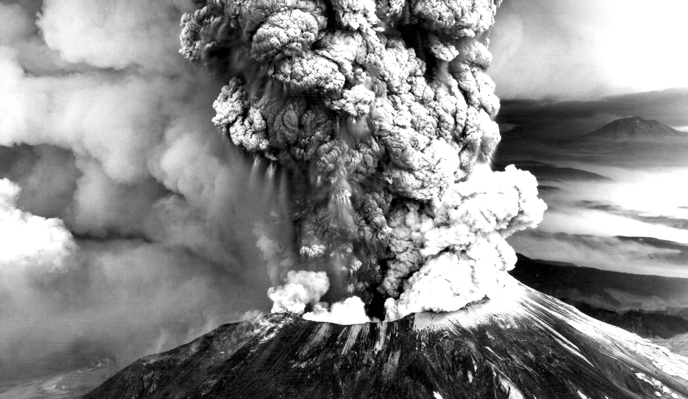 Novarupta's eruption column was similar to Mount Saint Helens in 1980, albeit much larger. USGS photo.
Novarupta's eruption column was similar to Mount Saint Helens in 1980, albeit much larger. USGS photo.
Such airborne volcanic ejecta, regardless of size, is called tephra. At Brooks Camp, the two most conspicuous types of tephra are ash and pumice. The important distinction between the two is size; pumice is commonly fist-sized, while a piece of ash is less than 2mm in diameter.
They are both formed from ejected magma as once confined gas explodes out of the cooling rock. This leaves the ash and pumice profoundly porous. Pumice is so porous, in fact, that it is a rock that floats.
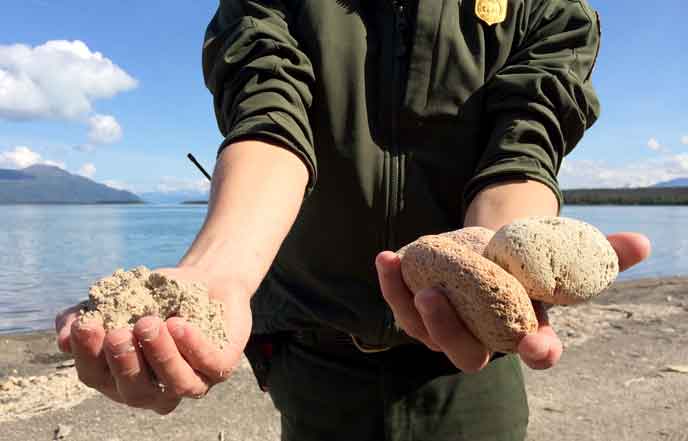
Ash (held in the ranger's right hand) and pumice (held in the ranger's left hand) were explosively ejected from Novarupta in 1912. NPS/M. Kaufman.
An explosive volcanic eruption has two primary characteristics, and both are equally dramatic. The first is a towering column of ash and pumice whose resulting ash fall covers the land, and in Katmai's experience, turned rivers into cement. The second characteristic is the collapse of the heavier rock fragments from the towering column that surge away from the vent in the form of fifteen-hundred degree avalanches of fiery fury. These are commonly known as pyroclastic flows. Visitors to Brooks Camp can travel twenty three miles on a lifted four-wheel drive school bus to the Valley of Ten Thousand Smokes to witness the incredible aftermath of these volcanic surges, depositing tephra ranging in size from ash to boulders, and transforming a once verdant valley into a stark desert-like moonscape.
But one need not leave Brooks Camp to discover an abundance of Novarupta's explosively induced volcanic creations, specifically, ash and pumice. Brooks Camp is most accessible by float plane. Float planes typically land on Naknek lake and park on a pumice covered beach. The pumice is abundant, vivid, and diverse, reflecting different types of magma. Some of this pumice is white, some brown, and some altered into vivid reds and yellows by exposure to extreme heat. An exciting discovery is the marble cake-like banded pumice—a combination of different magmas. Remember, the pumice belongs to us all, so leave it for future intrigued visitors to discover, examine, and ponder.
Ash, though, is not so conspicuous. A century has passed since Novarupta's outburst, and with it a couple inches of soil and rich toppings of tundra have layered on top. But no digging is necessary to find it, because exposed around camp are convenient opportunities to find ash from one of the greatest eruptions in recorded history:
1. Cross the Brooks River bridge towards the viewing platform. After some bear viewing, continue on the gravel road, which runs adjacent to the platform, for one-quarter of a mile. Native spruce bark beetles have girdled and killed a majority of the evergreen spruce trees at Brooks Camp, and when they fall over, their roots carry up with them a thick layer of ash. You'll come to another road on left, but keep straight for ten yards and you'll find this particular fallen tree on the right side of the road. Additionally, if you continue another fifty yards up the road, you'll find a similar fallen tree on the the left side of the road.
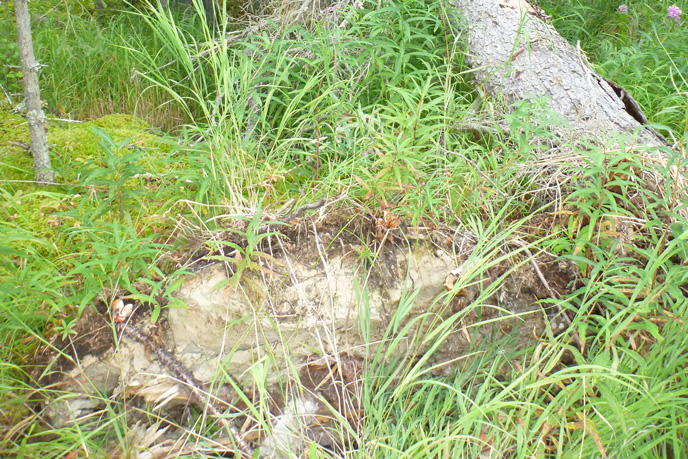
Ash is exposed by many fallen spruce trees in the Brooks River area. NPS/M. Kaufman.
2. Continue on the same road for a half mile. During this walk you will pass a junction with an opportunity to go left. Keep straight after passing this junction and continue for about seventy yards. On the the right side of the road you will find a fine illustration of Novarupta's ash, and layered above it is revegetated tundra, willow, and young spruce.
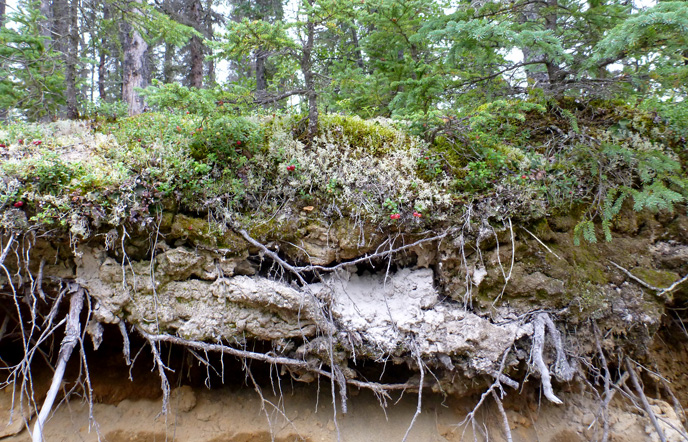
A road cut exposes ash from the 1912 eruption. NPS/M. Kaufman.
3. You won't need to cross the bridge or venture far from the river to see this exposed ash. In fact, you may not need to leave your porch: you'll find it across from Brooks Lodge cabin number 33.
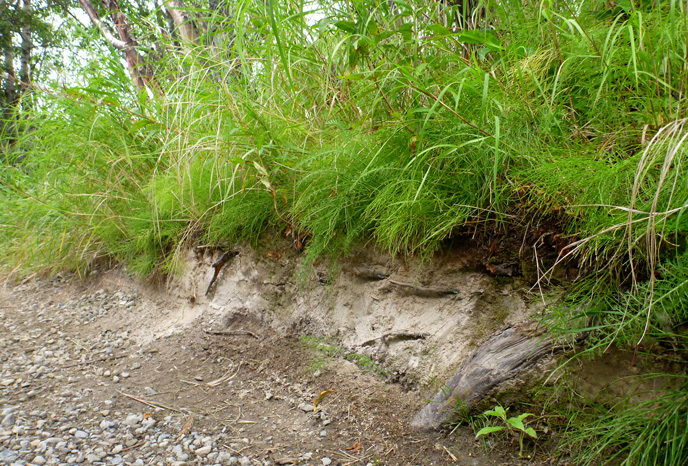
Ash is exposed along a trail near room 33 at Brooks Camp. NPS/M. Kaufman.
4. Park rangers recommend a three mile round-trip hike up to the Mount Dumpling overlook where visitors are afforded both a view of the Brooks River in its entirety and a good idea why such a profound concentration of bears visit the river in both July and September. Portions of the Mt. Dumpling trail have been worn away by foot traffic, exposing the telltale ash throughout the journey up and down Mt. Dumpling.
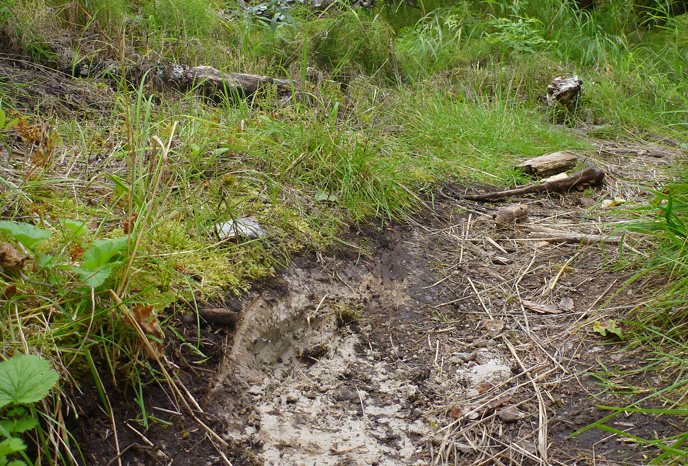
Bears occasionally expose ash along the Dumpling Mountain Trail. NPS/M. Kaufman.
The tephra at Brooks Camp can certainly serve as a poignant reminder of the explosive tendencies of Katmai's volcanoes, but what is not so clearly accessible is what lies underneath Novarupta's ash. As you may have already supposed, the dramatic events of 1912 are far from unique. Portions of the ground around the Brooks River have been excavated to help better understand four-thousand years of human history along both of the river's banks. Pottery, tools, and bones are not the only discoveries of interest. Over a depth of around ten feet, there are ten distinct ash layers preserved in the ground; in turn these ash layers preserve the soils, and what's been left in them.
The ash has been a consistent, if not habitual character in Katmai's dynamic story for quite some time. Ash will rain down again from a darkened sky, sealing beneath it another layer of soil, another of Katmai's chapters, and this time, it's ours.
 Multiple ash layers in Brooks Camp's soil reveal a long record of volcanic eruptions on the Alaska Peninsula. NPS/D. Vinson.
Multiple ash layers in Brooks Camp's soil reveal a long record of volcanic eruptions on the Alaska Peninsula. NPS/D. Vinson.
